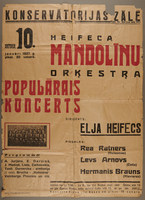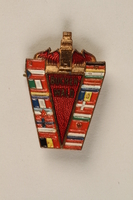Overview
- Description
- Contain approximately 88 photographs along with documents, correspondence, and sheet music that relate to the experiences of Elja Heifecs during the Holocaust in Riga, Latvia.
- Credit Line
- United States Holocaust Memorial Museum Collection, Gift of Samuel Heifetz
Physical Details
- Genre/Form
- Music--Manuscripts. Photographs. Postcards.
- Extent
-
1 box
Rights & Restrictions
- Conditions on Access
- There are no known restrictions on access to this material.
- Conditions on Use
- Material(s) in this collection may be protected by copyright and/or related rights. You do not require further permission from the Museum to use this material. The user is solely responsible for making a determination as to if and how the material may be used.
Keywords & Subjects
- Geographic Name
- Riga (Latvia).
Administrative Notes
- Holder of Originals
-
United States Holocaust Memorial Museum
- Legal Status
- Permanent Collection
- Provenance
- The papers were donated to the United States Holocaust Memorial Museum in 2005 by Samuel Heifetz.
- Record last modified:
- 2024-04-01 11:42:08
- This page:
- https://collections.ushmm.org/search/catalog/irn523432
Download & Licensing
- In Copyright - Use Permitted
- Terms of Use
- This record is not digitized and cannot be downloaded online.
In-Person Research
- Request 7 Days in Advance of Visit
- Plan a Research Visit
-
Request in Shapell Center Reading Room
Bowie, MD
Contact Us
Also in Elja Heifecs collection
The collection consisting of a two prisoner badges, a commemorative pin, a poster, correspondence, documents, photographs, and sheet music relating to the experiences of Elja Heifecs who was imprisoned in Riga ghetto, Kaiserwald, Muhlgraben, Stutthof, and Buchenwald concentration camps during the Holocaust and in Riga, Latvia, before, during, and after the Holocaust.
Date: 1937-1968

Text only poster for a musical performance in prewar Riga
Object
Announcement for a concert featuring 25 year old Elja Heifecs and his Mandolin Orchestra in Riga, Latvia, on January 10, 1937. In July 1941, Germany declared war on the Soviet Union and invaded Latvia which had been annexed by the Soviets in 1940. A vicious pogrom was unleashed upon the Jews of Riga by German killing squads and roving gangs of Latvian fascists. In October, Elja and his family were forced into the ghetto. His 22 year old brother was told to report to work at a factory and never returned. Over three days in December, the Germans, with Latvian support, rounded up and killed at least 26,000 Jews in the forests outside the town; Elja’s parents were murdered on December 8. In December 1943, as the Germans were preparing to destroy the ghetto, Elja was deported to Kaiserwald concentration camp, then to Muhlgraben, Stutthof, and in August 1944, to Buchenwald. He did hard labor in the rock mines, until one day a kapo found out that he could play the guitar and made him his servant. In April 1945, as Allied forces moved towards the camp, the prisoners were sent on a death march to Theresienstadt. The camp was liberated in May by the Soviet Army. After Elja recovered from typhus and severe malnutrition, he returned to Riga, the only survivor of his extended family. He resumed his career as a musician. though he could no longer play the cello due to the severe damage to his hands from the hard labor.

Handmade prisoner badge worn by a Latvian Jewish concentration camp inmate
Object
Prisoner patch used by Elja Heifecs when he was imprisoned in Buchenwald concentration camp, Rehmsdorf section, in 1944. In July 1941, Germany invaded Latvia. A vicious pogrom was unleashed upon the Jews of Riga by German killing squads and roving gangs of Latvian fascists; thousands were murdered. In October, Elja, a musician and band leader, with his parents and brother, was forced into the ghetto. One day, his 22 year old brother, Liebel, was told to report to work at a factory and never returned. Over three days in December, the Germans, with Latvian support, rounded up and killed at least 26,000 Jews in the forests outside the town; Elja’s parents were murdered on December 8. In December 1943, as the Germans were preparing to destroy the ghetto, Elja was deported to Kaiserwald concentration camp, then to Muhlgraben, Stutthof, and in August 1944, to Buchenwald. He did hard labor in the rock mines, until one day a kapo found out that he could play the guitar and made him his servant. In April 1945, as Allied forces moved towards the camp, the prisoners were sent on a death march to Theresienstadt. The camp was liberated in May by the Soviet Army. Elja weighed 84 pounds and was sick with typhus and pneumonia. After he recovered, he returned to Riga, the only survivor of his extended family. He resumed his career as a musician, though he could no longer play the cello due to the severe damage to his hands from the hard labor.

Handmade prisoner badge worn by a Latvian Jewish concentration camp inmate
Object
Prisoner patch worn by Elja Heifecs when he was imprisoned in Buchenwald concentration camp, Rehmsdorf section. In July 1941, Germany declared war on the Soviet Union and invaded Latvia which had been annexed by the Soviets in 1940. A vicious pogrom was unleashed upon the Jews of Riga by German killing squads and roving gangs of Latvian fascists. In October, Elja and his family were forced into the ghetto. His 22 year old brother was told to report to work at a factory and never returned. Over three days in December, the Germans, with Latvian support, rounded up and killed at least 26,000 Jews in the forests outside the town; Elja’s parents were murdered on December 8. In December 1943, as the Germans were preparing to destroy the ghetto, Elja was deported to Kaiserwald concentration camp, then to Muhlgraben, Stutthof, and in August 1944, to Buchenwald. He did hard labor in the rock mines, until one day a kapo found out that he could play the guitar and made him his servant. In April 1945, as Allied forces moved towards the camp, the prisoners were sent on a death march to Theresienstadt. The camp was liberated in May by the Soviet Army. After Elja recovered from typhus and severe malnutrition, he returned to Riga, the only survivor of his extended family. He resumed his career as a musician. though he could no longer play the cello due to the severe damage to his hands from the hard labor.

Pin issued to a camp survivor with Buchenwald memorial Bell Tower and flags
Object
Commemorative pin issued to Elja Heifecs, a former inmate of Buchenwald concentration camp, by the GDR (German Democratic Republic / East Germany) in 1969 to commemorate the 25th anniversary of the liberation of Buchenwald on April 11, 1945. The pin is decorated with the memorial Bell Tower built on the site in 1958 by East Germany and the flags of the eighteen countries whose citizens were imprisoned and killed there during the Holocaust. In July 1941, Germany declared war on the Soviet Union and invaded Latvia which had been annexed by the Soviets in 1940. A vicious pogrom was unleashed upon the Jews of Riga by German killing squads and roving gangs of Latvian fascists. In October, Elja and his family were forced into the ghetto. His 22 year old brother was told to report to work at a factory and never returned. Over three days in December, the Germans, with Latvian support, rounded up and killed at least 26,000 Jews in the forests outside the town; Elja’s parents were murdered on December 8. In December 1943, as the Germans were preparing to destroy the ghetto, Elja was deported to Kaiserwald concentration camp, then to Muhlgraben, Stutthof, and in August 1944, to Buchenwald. He did hard labor in the rock mines, until one day a kapo found out that he could play the guitar and made him his servant. In April 1945, as Allied forces moved towards the camp, the prisoners were sent on a death march to Theresienstadt. The camp was liberated in May by the Soviet Army. After Elja recovered from typhus and severe malnutrition, he returned to Riga, the only survivor of his extended family. He resumed his career as a musician. though he could no longer play the cello due to the severe damage to his hands from the hard labor.



